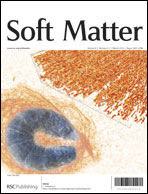Unexpected liquid crystalline behaviour of three-ring bent-core mesogens: bis(4-subst.-phenyl) 2-methyl-iso-phthalates†‡
Abstract
Three-ring bent-core bis(4-subst.-phenyl) 2-methyl-iso-phthalates exhibiting nematic, SmA and SmC phases are reported. The occurring mesophases have been identified by their optical textures and


 Please wait while we load your content...
Please wait while we load your content...